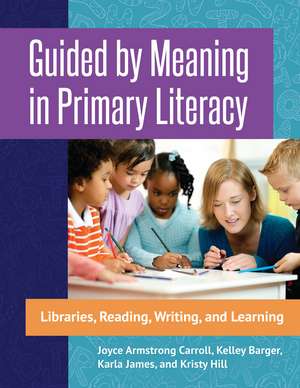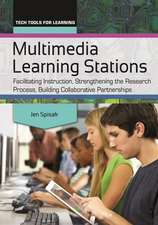Guided by Meaning in Primary Literacy: Libraries, Reading, Writing, and Learning
Autor Joyce Armstrong Carroll, Kelley Barger, Karla James, Kristy Hillen Limba Engleză Paperback – 11 dec 2016 – vârsta până la 17 ani
Preț: 275.17 lei
Preț vechi: 327.11 lei
-16% Nou
Puncte Express: 413
Preț estimativ în valută:
52.67€ • 57.23$ • 44.27£
52.67€ • 57.23$ • 44.27£
Carte tipărită la comandă
Livrare economică 21 aprilie-05 mai
Preluare comenzi: 021 569.72.76
Specificații
ISBN-13: 9781440843983
ISBN-10: 1440843988
Pagini: 320
Ilustrații: 119 bw illus
Dimensiuni: 216 x 279 x 22 mm
Greutate: 0.91 kg
Editura: Bloomsbury Publishing
Colecția Libraries Unlimited
Locul publicării:New York, United States
ISBN-10: 1440843988
Pagini: 320
Ilustrații: 119 bw illus
Dimensiuni: 216 x 279 x 22 mm
Greutate: 0.91 kg
Editura: Bloomsbury Publishing
Colecția Libraries Unlimited
Locul publicării:New York, United States
Caracteristici
Reminds readers of the inherent joy and value of working with young children by telling them stories and engaging them in magical early literacy activities in the classroom and library
Notă biografică
Joyce Armstrong Carroll, EDD, HLD, codirector of Abydos Literacy Learning, is the author of more than 20 professional books and more than 50 professional articles.Kelley Barger, EDD, is professor and director of reading programs at Fontbonne University, St. Louis, MO.Karla James is an educator with 15 years of experience with the Alvin Independent School District in Texas.Kristy Hill, MLS, is a library media technology specialist for Keller Independent School District, Keller, TX.
Cuprins
ForewordKathi AppeltIntroductionJoyce Armstrong CarrollPART I: TRUE LITERACYJoyce Armstrong Carroll1 Play and Literacy for the Young LearnerPlay in the Growth of LiteracyTo Recap2 Books and the Growth of LiteracyReading Guided by MeaningThe EvidenceFurther EvidenceBooks as FoundationalTo Recap3 Writing Guided by MeaningThe Delight to WriteWhy Children WriteTo Recap4 The History of the AlphabetFrom the BeginningFrom Caves to ClassroomsThe Wonder of Symbolic Language: The AlphabetA Visual History of the AlphabetTo Recap5 Literacy in SchoolsTo RecapPart I ReferencesPART II: WHY WRITE IN THE LIBRARY?Kristy Hill6 What Does the Teacher Librarian Have to Offer?Advocating for Writing Instruction in the LibraryIntegrating TechnologyBecoming a Champion of WritingMaking Literacy FunCreating a Space That Promotes Literacy7 Librarians Can Teach LiteracySight Word GamesGenresGrammar IntegrationModel Reading and Writing8 Library NotebooksGetting StartedManaging Journals9 Library Minilessons for Reader's ResponseScaffolding One Lesson Across Grade LevelsUsing Mentor TextsMinilessons and Informational TextMinilessons and Narrative Text10 Making Reading and Writing Connections in the LibraryModel ThinkingMaking ConnectionsReader's Response11 Modifying Hexagonal Writing in the LibraryModeling the Hexagonal StrategyTime ManagementNotecard Houses12 Establishing a Writer's Workshop in the LibraryManaging MaterialsMaking Time for WritingPrewriting ActivitiesPublishing13 Research Should Not Be an End-of-the-Year LessonThe Question JarMethodResources14 Give Students a VoiceNo More Quiet LibrariesPromoting Collaboration and CommunicationConclusionPart II ReferencesPART III: GUIDED BY MEANING THROUGH EARLY LITERACYKelley Barger15 Balanced LiteracyPrescriptive ApproachBasal ReadingLeveled ReadersLanguage Experience Approach and WorkshopLiterature-Based InstructionAnalogy-Based InstructionEmbedded PhonicsWhole LanguageBalanced LiteraryReading: Independent ReadingReading: Guided ReadingReading: Shared ReadingReading: Read AloudWriting: Independent WritingWriting: Guided WritingWriting: Shared WritingWriting: Interactive Writing16 Components of LiteracyReadingWritingViewingSpeaking and Listening17 How the Emergent Learner's Brain Works18 Phonemic AwarenessPhonological Awareness: The Deep-Seated Tradition of Oral Language and Scaffolds in the Sounds of LanguagePhonemic Awareness: How Phonemes Make Sounds That Blend to Make WordsPhonics Awareness and Mastery: Manipulating Sounds and Symbols to Make Words and MeaningCueing Systems of Reading19 Sight Word DevelopmentInstant WordsHigh-Frequency Words Inside Word WallsHigh-Interest Words Inside Word Banks20 Literacy Lesson DevelopmentScaffolding Literacy Experiences with Children's LiteratureExperiencing Children's Literature in All Facets of Literacy: Priming the Students and the TextExtending the Story ExperiencesDebriefing the Learning and Fostering Connections21 Reaching All LearnersReading and Writing BenchmarksDeveloping Authentic AssessmentLessons to Reach Out to ELL StudentsFamily Literacy: Inviting the Family into the Literacy JourneyPart III ReferencesPART IV: GUIDED BY MEANING IN TEACHING LESSONSKarla James22 The Arenas of Writing and Spelling: A Gradual Progression of Writing and Spelling DevelopmentAn Overview of the Arenas of Writing and SpellingApplicationThe ProgressionConsider This23 Ready, Set, Go! Practical Lessons to Engage, Explore, and Execute the Writing ProcessGetting Started with Writing WorkshopThe LaunchWhat Is Writing Workshop?Interactive WritingOral StorytellingConsider This24 The Writing ProcessPrewritingDraftingRevisingEditingPublishingSelf-ReflectionConsider This25 Units of StudyPersonal Narrative Unit of StudyHow-To Unit of StudyPoetry Unit of StudyConsider ThisPart IV ReferencesEpilogueJoyce Armstrong CarrollTo RecapAppendix A: Mentor Texts for Library LessonsAppendix B: Abydos Customized Book Bundle List of Titles for Grades PreK-2Index
Recenzii
This manual makes a compelling case for writing as an important facet of children's library experiences. . . . Experienced teacher librarians will appreciate the workable advice to be found in this title.
A practical and important book on supporting early literacy in schools and libraries with lessons in writing and reading. The title's most crucial arguments are that literacy (and, for that matter, anything) should resonate with those we teach and that 'brain research has supported meaningful instruction for decades and continues to support it by proving that the brain neither attends nor retains what it perceives as meaningless'-a powerful statement backed up by research. The authors are successful in demonstrating how libraries can extend learning in deep and powerful ways. They highlight examples of student writing anecdotes from the real world and make connections between theory and practical application. While the text is grounded in research, Carroll, Barger, James, and Hill don't neglect to present lessons and stories that reflect the true joy of reading and how magical early literacy activities can be for young children. VERDICT A must-read for early childhood educators.
Teachers of children in first to second grades will find this handbook meaningful and liberating, and librarians can offer this book as an excellent reference. Recommended.
A practical and important book on supporting early literacy in schools and libraries with lessons in writing and reading. The title's most crucial arguments are that literacy (and, for that matter, anything) should resonate with those we teach and that 'brain research has supported meaningful instruction for decades and continues to support it by proving that the brain neither attends nor retains what it perceives as meaningless'-a powerful statement backed up by research. The authors are successful in demonstrating how libraries can extend learning in deep and powerful ways. They highlight examples of student writing anecdotes from the real world and make connections between theory and practical application. While the text is grounded in research, Carroll, Barger, James, and Hill don't neglect to present lessons and stories that reflect the true joy of reading and how magical early literacy activities can be for young children. VERDICT A must-read for early childhood educators.
Teachers of children in first to second grades will find this handbook meaningful and liberating, and librarians can offer this book as an excellent reference. Recommended.



